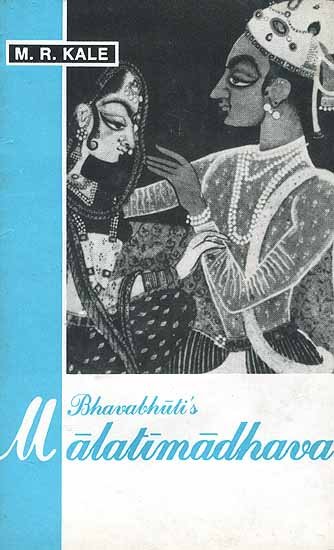Malatimadhava (study)
by Jintu Moni Dutta | 2017 | 52,468 words | ISBN-10: 8120813057 | ISBN-13: 9788120813052
This page relates ‘Meaning of Rasa (aesthetic enjoyment)’ from the English study on the Malatimadhava of Bhavabhuti:—A Prakarana type of Drama in ten acts revolving around the love-story of Malati (from Padmāvatī) and Madhava (from Vidarbha). This study discusses the history of its author and the literary, social, religious, historical and cultural aspects of the Malatimadhava.
Part 1.1 - Meaning of Rasa (aesthetic enjoyment)
Etymologically rasa means what is relished, tested and enjoyed.[1] Rasa is the emotional content of literary and dramatic art which led to relish. From the view point of a reader or spectator rasa is actual relish or aesthetic enjoyment of a moving emotional experience. Bharatamuni, the author of Nāṭyaśāstra,opines that no meaning proceeds from speech without sentiment.[2]
Further he says that the sentiment is produced from a combination of:
- vibhāva i.e determinants,
- anubhāva i.e consequents and
- vyabhicāribhāva i.e transitory states.[3]
The rasa is so called because it is capable of being tested.[4] The later rhetoricians after Bharata like Bhāmaha[5] in his Kāvyālaṃkāra and Daṇḍīn[6] in his Kāvyādarśa have included the rasa within the figure of speech rasavat. While Vāmana, in his Kāvyālaṃkārasūtravṛtti is found to have recognized an element within the arthaguṇa called Kānti.[7] Bhojarāja, in his Sarasvatīkaṇṭhābharaṇam, opines that a poetic piece possessing rasa brings fame and pleasure for the poet.[8] Abhinavagupta, in his famous commentary Locana on Dhvanyāloka of Ᾱnandavardhana,clearly states that the rasadhvani is the principal kind of dhvani (suggestion) which is the soul of the poetry.[9]
Mammaṭabhaṭṭa opines that what are known in ordinary language as causes, effects and auxiliaries of latent emotion of love and the like come to be spoken as vibhava, anubhāva and vyabhicāribhāva when found in the drama and the latent emotion comes to be manifested by these is known as rasa. He says that rasa is the melting point of mind.[10] In the Abhinavabhāratī, it is said that a rasa runs like a thread in a dramatic representation.[11] In this regard, Viśvanātha rightly says that rasa (sentiment) is the soul of poetry.[12]
The Sanskrit theory of rasa has a very sound psychological base. The various characters that are presented in the composition are actuated by varying bhāvas i.e. feelings and emotions generally remain dormant in the heart of a person.Bharata opines that bhāvas are those elements which originate the sentiments in connection with various modes of dramatic representation in such a way that a tree grows from a seed and also flower and fruits are obtained from a tree.[13] These feelings are intensified by suitable ālambanas (indirect cause) and uddīpanas (excitants) respectively. They are expressed in the form of corresponding anubhāvas. Occasionally these are supported by various feelings which are invariably of a transitory character. The process of the awakening and manifestation of emotions is the same in ordinary life as well. However, in composition the touch of the poetic genious transforms these emotions in such a wonderful manner that the sympathetic reader or the listener (sahṛdaya) invariably experiences them as delight. These emotional delight experienced by a sahṛdaya in composition is technically known as rasa.[14]
In other words, rasa is manifested in the heart of sahṛdaya when the sthāyībhāva like rati etc. are stimulated by vibhāva.[15] The exciting causes or determinants are vibhāvas by which emotions are risen.
This vibhāva is of two types viz.,
- ālambanavibhāva and
- uddīpanavibhāva.
The main stimulating cause is called ālambanavibhāva and the environmental factor which act as additional cause is called uddīpanavibhāva.[16]
This vibhāva follows and accompanies an emotional impact, i.e.
- the physical factor called anubhāva; and
- the mental factor called vyabhicāribhāva.[17]
A poetic construction of an emotional experience appears, thus, to be a combination of these causelty related factors.
Hence, Bharata says—
vibhāvānubhāvavyabhicārisaṃyogādrasaniṣpatiḥ.[18]
For the presentation of rasa the material consists of:
Footnotes and references:
[1]:
rasa iti kaḥ padārthaḥ /
ucyate āsvādyatvāt //
Nāṭyaśāstra of Bharatamuṇi, ed.
by Ramakrishna Kavi with the commentary of Abhinavabhāratī,VI.p.288
[2]:
na hi rasādṛte kaścidarthaḥ pravartate /
Ibid.,VI.p.272
[3]:
tatra vibhāvānubhāvavyabhicārisaṃyogādrasaniṣpattiḥ / Ibid.
[5]:
rasavaddarśitaspaṣṭaśṛṅgārādirasāṃ yathā /
Kāvyālaṃkāra, III.6
[8]:
[9]:
yastu svapne'pi na svaśabdavācyo no laukika vyavahāra patitaḥ, kintu śabdasamar pyamāṇahṛdayasambādasundaravibhāvānubhāvasamucitaprāgniviniviṣṭaratyādi vāsanānurāgasukumārasvasaṃvidānandacavarṇāvyāpārarasanī-yaruporasaḥ,sakāvya vyāpāraikagocaro rasadvaniriti, sa ca dhvanireveti, sa eva mukhyatayātmeti//
Dhvanyāloka of Ānandavardhana, ed. by Achārya Jagannāth Pāthak with the
Locana Sanskrit Commentary, p.50
[10]:
[11]:
eka eva tāvatparamārthato rasaḥ /
sūtrasthāni yatvāna rūpake pratibhāti //
Abhinavabhāratī,Vol.I.p.273
[12]:
vākyaṃ rasātmakaṃ kāvyam /
Sāhityadarpaṇa,I.4
[13]:
[14]:
[15]:
ratyādyudbodhakā loke vibhāvāḥ kāvyanāṭyayoḥ /
Ibid.,III.29
[16]:
ālambanoddīpanākhyo tasya bhedāvubho smṛto /
Ibid.
[17]:
vibhāvā aubhāvāścasāttvikā vyabhicāriṇaḥ / Ibid.,III.p.94
[18]:
tatra vibhāvānubhāvavyabhicārisaṃyogādrasaniṣpatiḥ /
Nāṭyaśāstra, I.p.274
